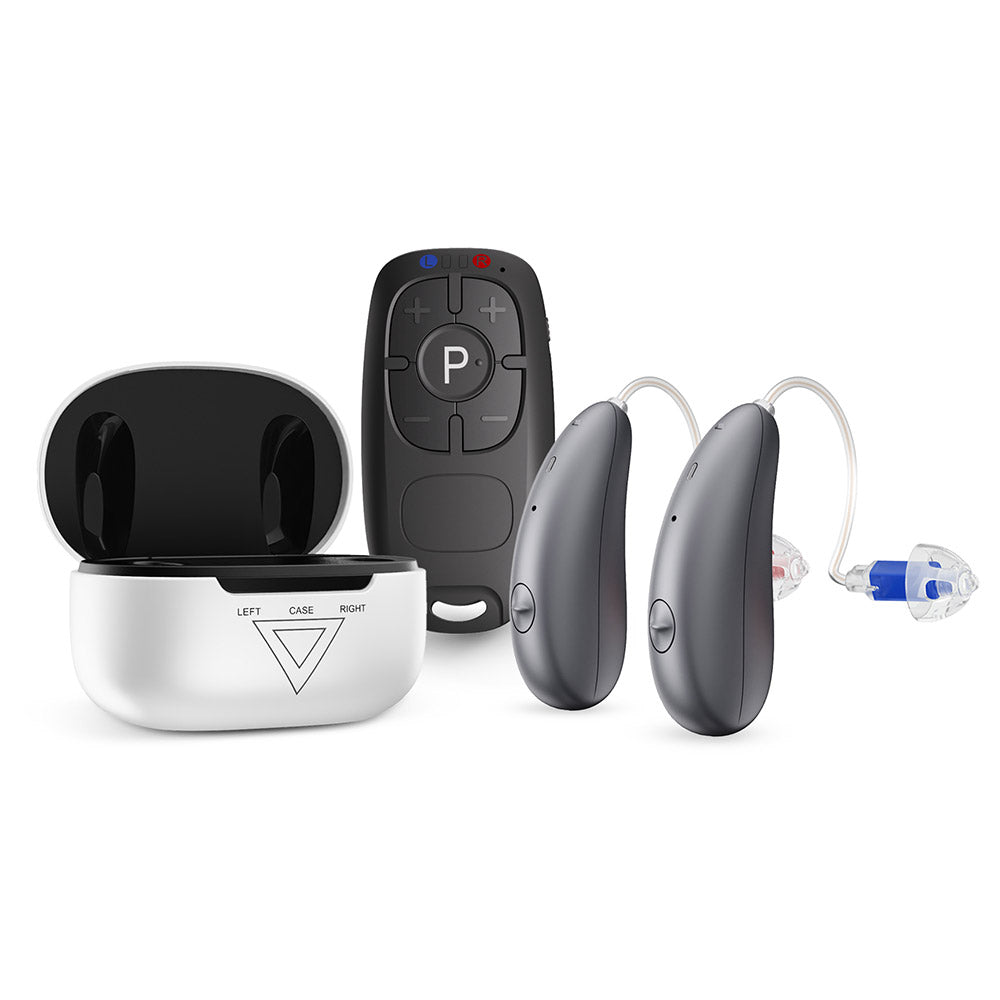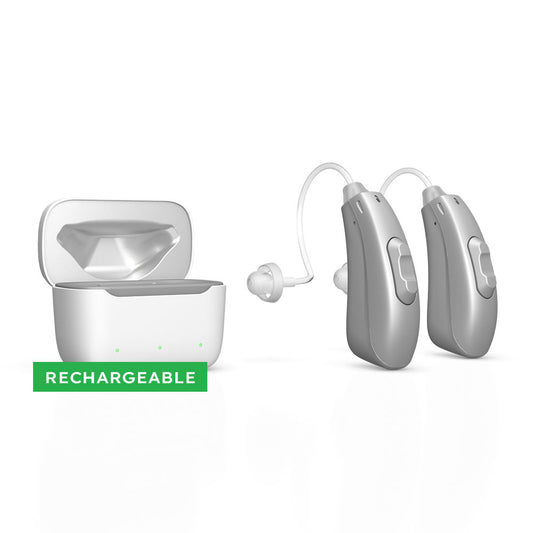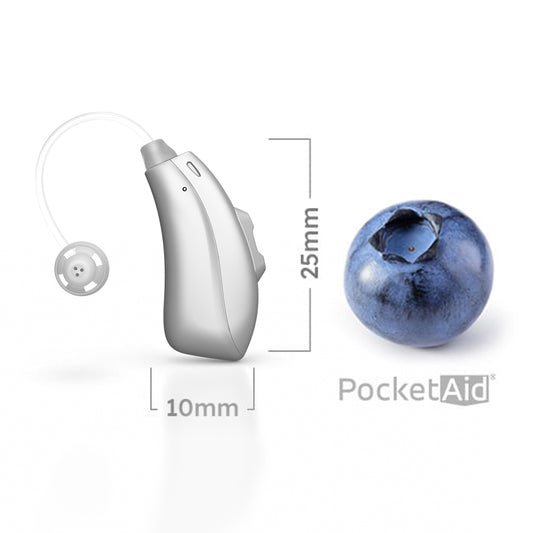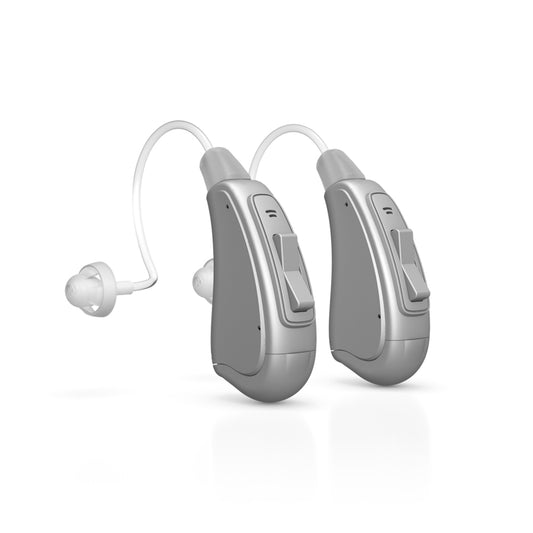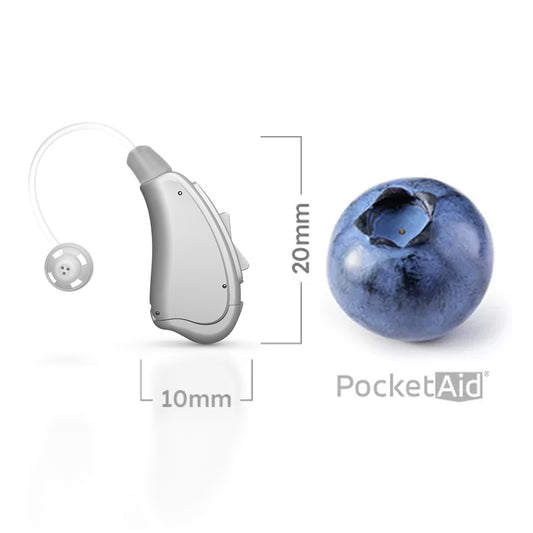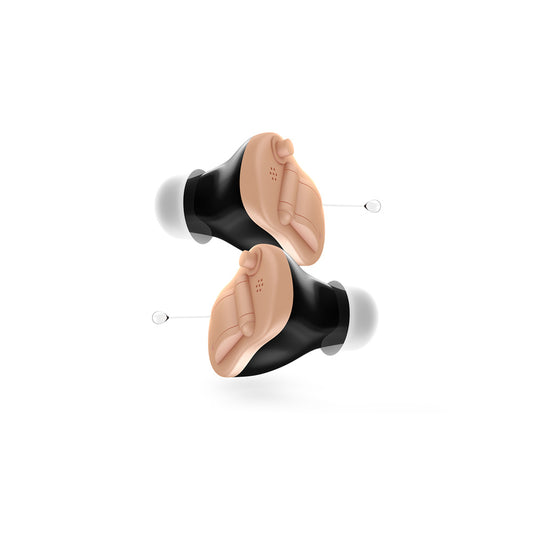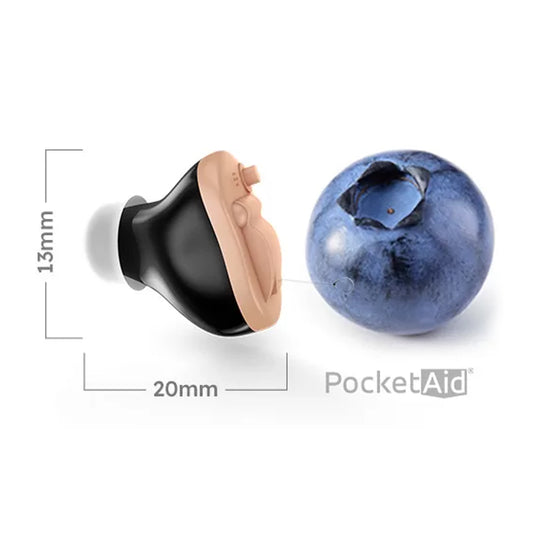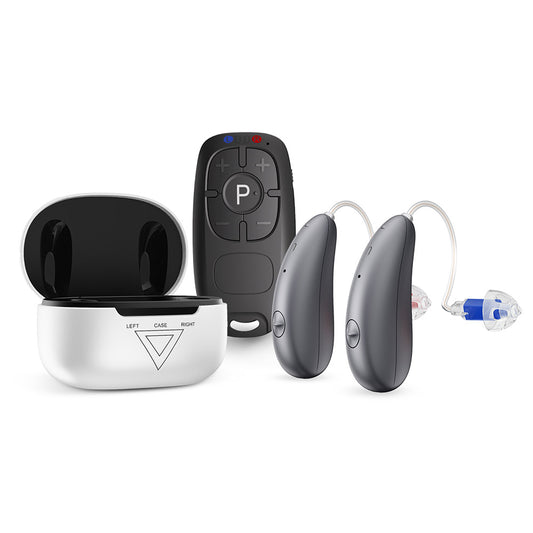Collection: Digital Hearing Aids
Order Your Digital Hearing Aids Online Today
Choose Your PocketAid™
-
Jaspa 3 Dura Rechargeable Hearing Aid
Vendor:PocketAid4.86 / 5.0
(298) 298 total reviews
Regular price From £449.00 GBPRegular priceUnit price / per -
Jaspa 3 BTE Hearing Aid
Vendor:PocketAidRegular price From £319.00 GBPRegular priceUnit price / per -
Spot Mini 6 Hearing Aid
Vendor:PocketAid4.37 / 5.0
(43) 43 total reviews
Regular price From £419.00 GBPRegular priceUnit price / per -
Diamond Stream 12 Rechargeable Bluetooth Hearing Aid
Vendor:PocketAidRegular price From £720.00 GBPRegular priceUnit price / per

Buying a PocketAid™ is Risk Free

30 Day Money-Back Guarantee

Free Fast Delivery Across the UK

3 Year Warranty on All Hearing Aids

Customer Service Guarantee
Clearer Sound, Smarter Processing
Digital hearing aids use advanced microchips to analyse and adjust sound in real time, offering a more refined and personalised hearing experience than older analogue models. They’re now the standard in hearing technology - quietly improving speech clarity, reducing background noise, and helping people stay more connected to everyday life.
Modern hearing aids incorporate advanced technology such as Bluetooth hearing aid technology and rechargeable hearing aids, delivering improved sound quality and a better user experience.
But what exactly are digital hearing aids? And what should you know before choosing one?
What Are Digital Hearing Aids?
Unlike analogue hearing aids, which simply amplify all sounds equally, digital hearing aids process sound using digital signal processing (DSP). That means they can distinguish between different types of sounds, like separating voices from background noise, and adjust amplification accordingly.
Most digital hearing aids use multiple sound channels to shape and optimise audio in real time. The result? Speech sounds clearer, background distractions are softened, and the overall listening experience feels more natural.
Digital models vary in how much control they offer, some adjust automatically, while others include user-adjustable settings or multiple listening modes for different environments.
Understanding the different aid types and hearing aid types, as well as selecting the right type of hearing aid for your individual needs, is essential for achieving the best results.
How Do Digital Hearing Aids Work?
Inside each device is a small processor that constantly monitors incoming sound. It analyses the audio, filters out unwanted noise, enhances speech, and delivers a cleaner signal to your ear - all within milliseconds. This real-time adjustment helps the hearing aid respond naturally to different environments without the need for manual tuning.
Some models also include directional microphones to focus on the person speaking in front of you, while others offer programs for specific listening settings like TV, group conversation, or outdoor use.
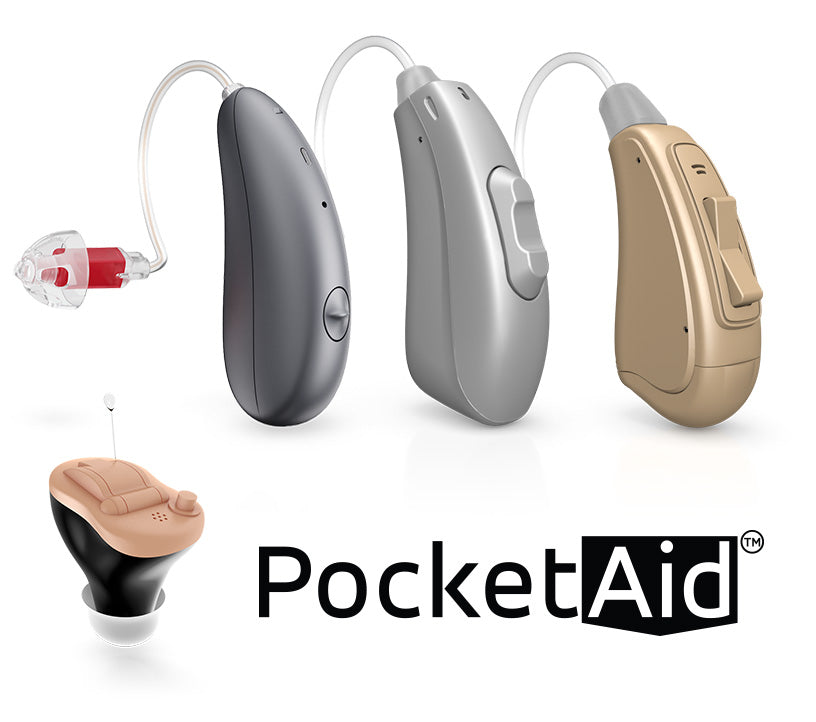
Types of Hearing Aids
When it comes to choosing the right hearing aid, understanding the different types of hearing aids available is essential. Each style is designed to address specific levels of hearing loss and personal preferences, ensuring you find the best fit for your lifestyle.
-
Behind-The-Ear (BTE) Hearing Aids:
These are among the most common and versatile types of hearing aids. BTE hearing aids sit comfortably behind the ear and are connected to an earpiece that fits inside the ear. They are especially effective for people with severe hearing loss, offering powerful amplification and a range of features.
-
Receiver-In-Canal (RIC) Hearing Aids:
RIC hearing aids are similar to BTE models but they offer additional benefits. The receiver sits inside the ear canal, connected by a thin wire to the main body behind the ear. This design provides excellent sound quality while remaining less noticeable.
-
In-The-Ear (ITE) Hearing Aids:
These fit entirely within the outer ear, making them easy to handle and suitable for mild to moderate hearing loss. They offer a balance between visibility and performance.
-
Completely-In-Canal (CIC) Hearing Aids:
Fitting completely in the canal, this option is perfect for those seeking the most discreet option, CIC hearing aids are custom-moulded to fit deep inside the ear canal. These are ideal for mild to moderate hearing loss and are virtually invisible when worn.
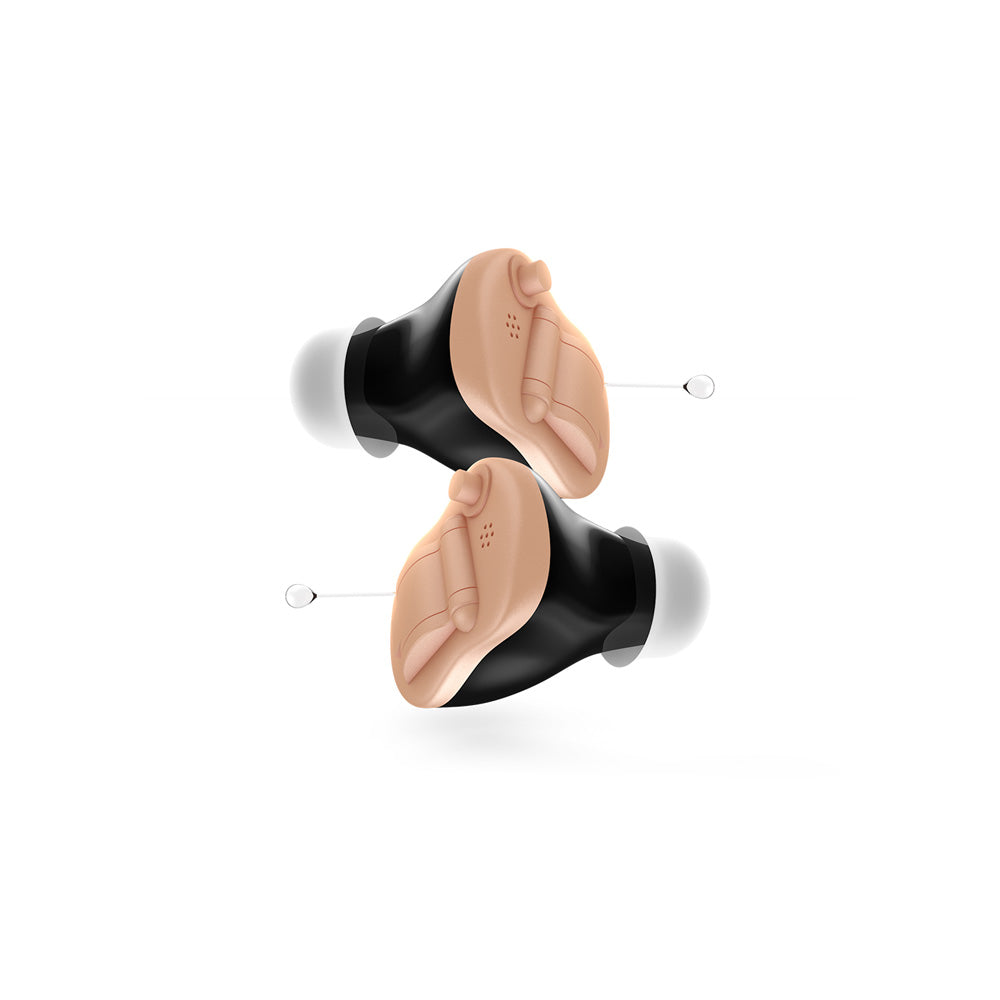
Invisible Hearing Aids
For those who value discretion, invisible hearing aids, also known as Completely-In-Canal (CIC) hearing aids, offer a truly hidden hearing solution. These tiny devices are custom-made to fit deep within your ear canal, making them virtually undetectable to others.
Invisible hearing aids are ideal for individuals with mild to moderate hearing loss who want to maintain a natural appearance without compromising on sound quality. Despite their small size, these aids are equipped with features such as noise reduction and feedback cancellation, ensuring exceptional sound quality in everyday situations.
Invisible hearing aids provide a comfortable, secure fit for all-day wear. If you’re looking for a discreet, effective way to improve your hearing, invisible hearing aids could be the perfect choice.
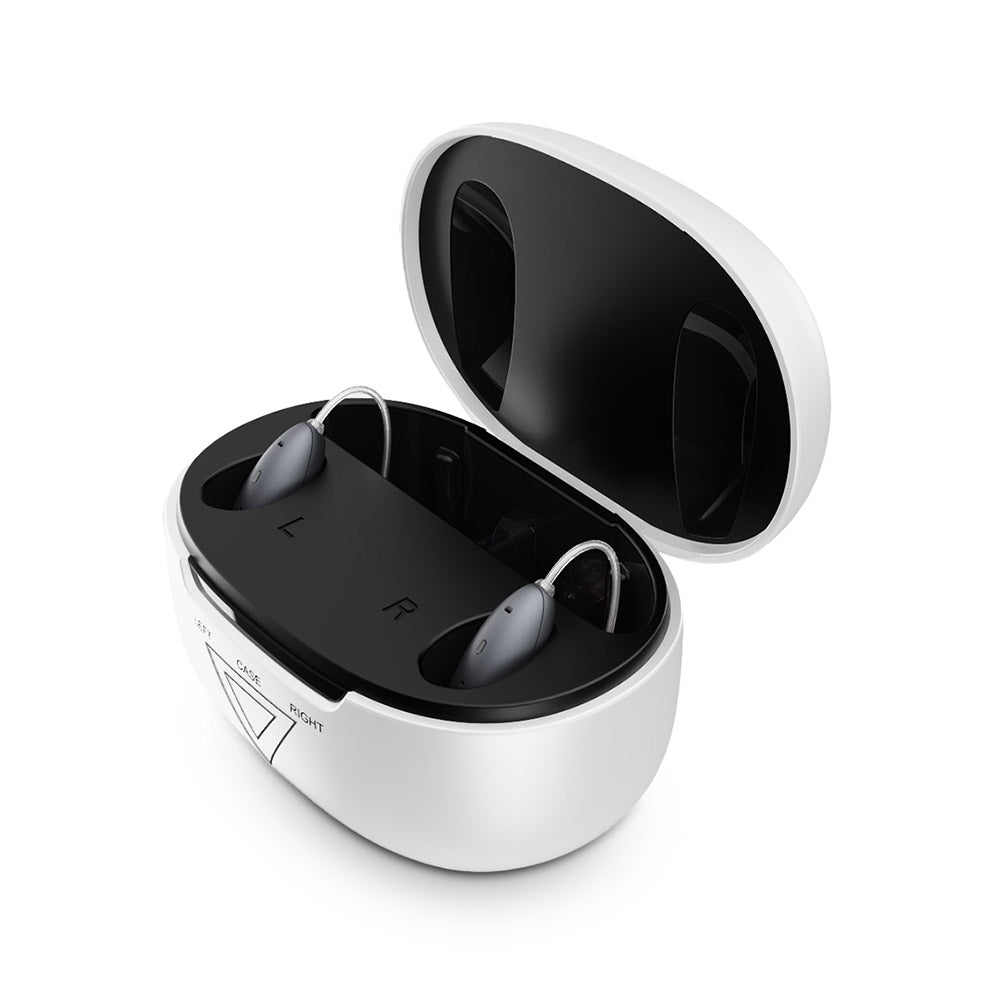
Rechargeable Hearing Aids
Rechargeable hearing aids are transforming the way people manage their hearing health, offering a convenient and sustainable alternative to traditional disposable batteries. You simply place your device in a charging dock overnight and wake up to a full day of reliable hearing.
These hearing aids are available in a variety of styles, including BTE, RIC, and more, so you can choose the model that best suits your needs. Not only do they reduce the hassle and ongoing cost of buying disposable batteries, but they’re also better for the environment.
Many rechargeable hearing aids come equipped with features like Bluetooth, allowing you to stream audio directly from your devices, and some even include AI technology for enhanced sound processing. With rechargeable hearing aids, you get the latest technology, greater convenience, and a more cost-effective hearing solution.
Are Digital Hearing Aids Right for You?
If you’ve found it hard to follow conversations or struggle with background noise, a digital hearing aid could make a noticeable difference. The suitability of digital hearing aids depends on your level of hearing and the type of hearing loss you have. They are most effective if you still have some hearing left, and are generally well suited for people with mild to moderate hearing loss, offering a clearer, more adaptable way to stay connected to daily life.
Wondering what kind of digital hearing aid might fit your needs? Take a closer look and see what feels right for you.
Analogue vs. Digital Hearing Aids: What’s the Difference?
When shopping for hearing aids, one of the most important distinctions to understand is the difference between analogue and digital hearing aids. While both types serve the same basic function – amplifying sound to improve hearing – they do so in very different ways.
In recent years, aid manufacturers and hearing aid manufacturers have largely shifted their focus towards digital technology, offering a wide variety of digital hearing aids across different ranges. Certain manufacturers provide exclusive or preferential arrangements with larger audiology providers, which can sometimes limit consumer choice. However, independent audiologists often have access to a broader selection of products from multiple manufacturers, including mid-range options that balance features and affordability. This variety in ranges, from entry-level to premium, means consumers can find hearing aids that best suit their needs and budget, with mid-range models often being a popular choice for everyday listening situations.
Features of Digital Hearing Aids
Modern digital hearing aids are packed with features designed to deliver exceptional sound quality and a seamless listening experience. These features not only improve how you hear but also how you interact with the world around you.
Noise Reduction:
Digital hearing aids use sophisticated algorithms to reduce unwanted background noise, making it easier to focus on conversations in busy environments.
Feedback Cancellation:
Say goodbye to the annoying whistling or squealing sounds. Feedback cancellation technology ensures a clear, comfortable listening experience.
Bluetooth Connectivity:
Many digital hearing aids now offer Bluetooth hearing aid technology, allowing you to connect wirelessly to smartphones, TVs, and other devices. Stream calls, music, and audio directly to your ears for more control and convenience.
Rechargeable Batteries:
Forget about constantly buying disposable batteries. Rechargeable hearing aids make daily use simple and eco-friendly, with many models offering a full day’s use on a single charge.
Artificial Intelligence (AI):
Some advanced digital hearing aids use AI technology to automatically adjust settings, improve speech recognition, and enhance sound quality in challenging, noisy places.
With these features, digital hearing aids offer a flexible, user-friendly solution that adapts to your daily life and delivers better hearing in every situation.
Benefits of Digital Hearing Aids
Improved Speech Clarity
Designed to make conversations easier to follow, especially in noisy environments like cafés, shops or group settings.
Adaptive Sound Processing
Many digital devices adjust automatically as your surroundings change—whether you’re in a quiet room or out in public.
Noise Reduction
Helps minimise background sounds that can make listening more difficult or tiring.
Feedback Suppression
Reduces the risk of unwanted whistling or squealing sounds that were common in older analogue devices.
Multiple Listening Profiles
Some digital hearing aids offer different modes or volume levels to suit various situations.
Finding the right solution tailored to your hearing needs can maximize the benefit of digital hearing aids.
-
How Analogue Hearing Aids Work
Analogue hearing aids use a continuous electronic signal to amplify all sounds around you. They increase volume across the board – voices, background noise, and everything in between. These devices were once the standard in hearing care but have largely been replaced due to their lack of customisation and adaptability.
-
How Digital Hearing Aids Work
With a digital hearing aid, incoming sound is converted into a digital code, analysed by a microprocessor, and then adjusted in real-time. The result is smarter, more selective amplification that enhances speech while reducing noise.
Digital models also offer features like feedback suppression, directional microphones, Bluetooth connectivity, and multiple listening modes that are designed to create a natural, customisable hearing experience.
Analogue vs Digital Hearing Aids
| Feature | Analogue Hearing Aids | Digital Hearing Aids |
|---|---|---|
| Sound Processing | Continuous signal amplification | Converts sound to digital code for smart processing |
| Noise Reduction | Minimal to none | Advanced noise filtering and suppression |
| Speech Clarity | Amplifies all sound equally | Prioritises voices, softens background noise |
| Customisation | Basic volume control | Multiple user profiles, modes and fine-tuning options |
| Feedback Suppression | Often prone to whistling/squealing | Built-in feedback cancellation to reduce whistling |
| Listening Environments | One-size-fits-all | Automatically adapts to different settings (e.g. café, outdoors) |
| Battery Efficiency | Typically longer battery life | Varies. Some rechargeable, some with replaceable batteries |
| Connectivity Features | None | Often includes Bluetooth for phone, TV and app control |
| Availability in 2025 | Rare and outdated | Industry standard; widely available in modern models |
| Best For | Very basic amplification needs | Anyone seeking clearer, smarter and more adaptive hearing support |
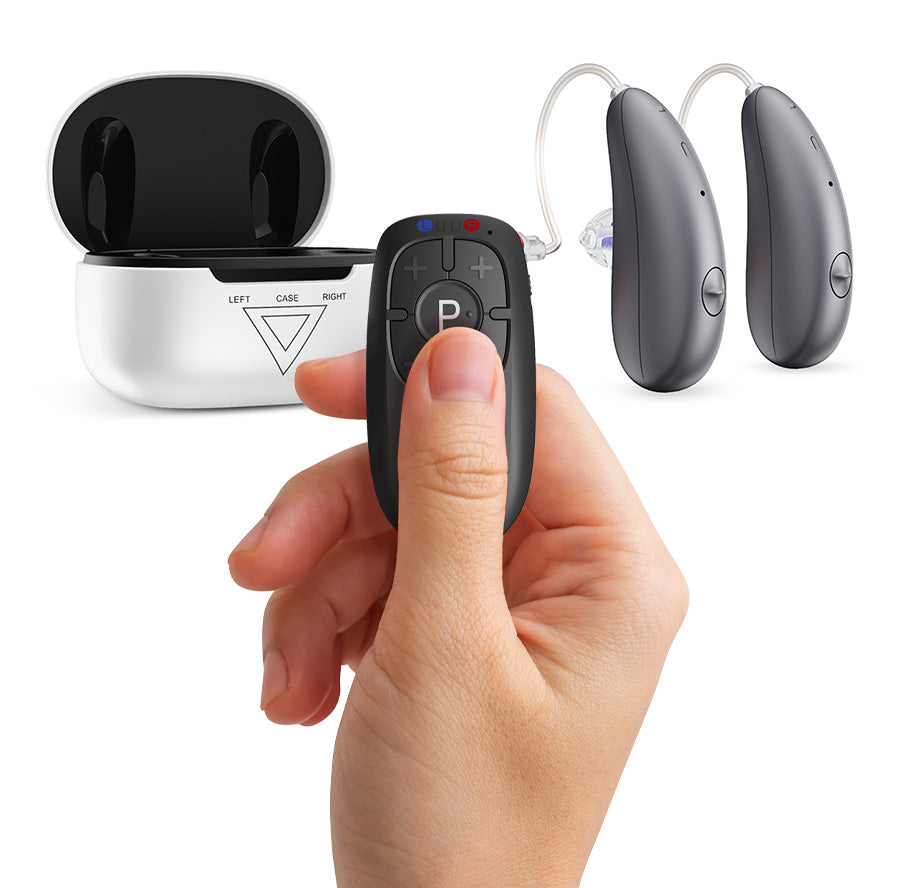
Meet the Diamond Stream 12: A smarter solution
Too many brands promise seamless tech but deliver frustration.
While other aid manufacturers may offer varying levels of Bluetooth integration and connectivity, the Diamond Stream 12 stands out for its advanced hearing aid features and superior performance compared to other hearing aids. The Diamond Stream 12 provides universal compatibility and ease of use.
That’s why we developed the Diamond Stream 12, to take the guesswork out of wireless hearing aid technology.
Why Digital Is the New Standard
With the rise of affordable digital hearing aids, such as PocketAid, more people are switching from analogue to enjoy clearer conversations, less noise fatigue and discreet high-tech designs.
Hearing Aid prices can vary depending on the hearing aid provider, hearing aid retailers, and different providers. The average price of hearing aids can differ depending on the type, and the cost can vary significantly between private options , NHS hearing aids, and over-the-counter hearing aids. When you buy hearing aids, the process and available options will vary depending on the provider, with private options typically offering advanced technology at a higher cost compared to OTC or NHS hearing aids.
Digital technology offers far greater control, comfort and confidence – especially in complex listening environments like busy restaurants, family gatherings or outdoor spaces.
If you’re still using an analogue device or looking to try your first hearing aid, a digital hearing aid from PocketAid will offer a superior and more natural experience.
Hear the difference for yourself
Not sure how a digital hearing aid will really sound in your everyday life? Now you can try it – no clinic, no commitment.
The PocketAid Hearing Aid Simulator is a free online tool that gives you a realistic taste of what modern digital hearing technology sounds like, all from the comfort of home without setting foot in a clinic.
Using the same EarWave™ technology found in PocketAid’s actual devices, the simulator lets you experience how the best digital hearing aids can enhance your environment. Whether you're in a busy café, talking on the phone, watching TV or simply chatting with family, the tool recreates how sounds are filtered, focused and clarified just like they would be through a real hearing aid.
It’s a quick and powerful way to understand the real-world impact of digital hearing aids, and it’s completely free.
Ready to explore the difference? Try the Hearing Aid Simulator now and discover the clarity you’ve been missing.
Choosing a Digital Hearing Aid
The perfect digital hearing aid for you will depend on personal lifestyle and physical factors.
Ask yourself:
- What environments do I spend most of my time in?
- Do I want to stream phone calls, music and TV?
- Would I find it difficult to handle and replace small batteries?
- Is discretion important to me?
- Am I comfortable using technology?
- Do I often forget to charge devices?
- Would a remote control be handy?
- Do I have mild, moderate or severe hearing loss?
If you're concerned about your hearing, booking a hearing test or a full hearing test can help ensure you are aware of your hearing health status, and whether or not you need hearing aids.
PocketAid provides welcome relief if you've been through the traditional hearing aid process that includes 'expert advice' from an audiologist, endless appointments, and expensive hearing aids, and been left feeling tired... or broke... or both! Scheduling follow up appointments isn't necessary with PocketAid. Our hearing aids come with ongoing support and to address any concerns after your initial purchase. When considering buying hearing aids, remember that most devices last three to five years, so you only need to replace hearing aids when necessary, not due to unnecessary upselling.
Try our handy, free Hearing Aid Selector tool to find the right digital hearing aid for you.
Hearing Aid Costs
Understanding hearing aid costs is an important step in your journey to better hearing. The price of hearing aids can vary widely depending on the type, technology, and features you choose. On average, a single hearing aid can cost between £800 and £3,000, while a pair may range from £1,500 to £5,000. High-end models with niche features can reach £6,000 or more.
While the initial investment may seem significant, it’s important to view hearing aids as an investment in your well-being and quality of life. Many hearing aid providers offer flexible financing options (PocketAid offers Klarna as a payment option), making it easier to spread the cost over time. Look for providers that include free aftercare, warranties, and support in their packages, as these can add significant value and peace of mind.
Some private health insurance plans may also help cover the cost of hearing aids, so it’s worth checking with your provider to see if you’re eligible. With a wide range of hearing aids and technology available, there are affordable options to suit every budget and hearing need.
Frequently Asked Digital Hearing Aid Questions
Do I need a hearing test before buying a digital hearing aid?
With PocketAid, it’s not necessary to have a hearing test. You can order online, without the need for a prescription, test or clinic visit.
Many people already know they’re struggling with hearing in certain situations, like conversations in busy places or hearing the TV at normal volumes.
If, however, you're concerned about a specific medical condition or have sudden hearing loss, we do recommend seeing your GP or a hearing specialist.
Can I try a digital hearing aid before I buy?
With PocketAid, you can try out the sound experience before committing. Our free online Hearing Aid Simulator lets you hear how our digital technology sounds in real-world environments, so you can make a confident decision from the comfort of home.
We also offer a 30-day money-back guarantee, so you can test your device in your daily life and return it if it's not the right fit. That means you can try a PocketAid hearing aid risk-free.
Are digital hearing aids easy to use for older adults?
Yes! Today’s digital hearing aids are designed with simplicity in mind. Our models feature easy-to-use, on-device volume and setting controls. You won’t need to download an app.
Our latest model, the Bluetooth-enabled Diamond Stream 12 also offers a handy, easy-to-use remote control that allows you to adjust volume and settings just as would with a TV remote.
Whether you're tech-savvy or not, you’ll find them easy to manage. And if you ever need help, our support team is just a call or click away.
How long do digital hearing aids last?
With proper care, most digital hearing aids last around five years, sometimes longer. Over time, your hearing needs may change, or you may want to upgrade to a newer model with more advanced features. PocketAid makes it easy to stay current without breaking the bank, thanks to our transparent pricing and flexible product options.
How long will I have to wait for my digital hearing aid?
Just 4-6 business days in the UK. When you’ve chosen the perfect PocketAid digital hearing aid for you, simply purchase online and your device will be delivered to your door. No waiting lists, no time-consuming clinic visits. Your digital hearing aid is ready to use straight out of the box.
How much do hearing aids cost?
PocketAid's rechargeable options start from just £449 per aid.
How much do hearing aids matter?
Hearing aids play a crucial role in improving communication, cognitive health, and overall quality of life for people with hearing loss. They make speech clearer in different environments, reduce listening effort, and help maintain mental sharpness. By restoring access to sounds that might otherwise be missed, hearing aids can boost confidence, reduce feelings of isolation, and enhance safety and independence in daily life.
Why go digital now?
Hearing is more than a sense, it’s how we stay connected to the people and moments that matter. Whether it’s sharing a joke with friends, hearing your grandchild’s first words or simply catching the punchline on your favourite TV show, sound is life.
If you’ve been relying on outdated analogue hearing aids, or going without any at all, it’s time to ask: what are you missing?
Just like PocketAid, traditional providers like Boots Hearingcare offer a wide range of hearing aids, including in the canal and other different styles, with options available to suit various needs and budgets. These ranges ensure there is a suitable solution for everyone, whether you are looking for features or affordability.
Modern digital hearing aids are smarter, clearer and tailored to your real-world environments. Imagine a device that knows the difference between chatter in a crowded café and a one-on-one conversation at home. One that filters out the noise you don’t want and enhances the voices you do. One that lets you live without constant adjustments or discomfort.
You deserve that ease, clarity and confidence. Once you experience it, you won’t know yourself.
For many people, the biggest reason they’ve persisted with older analogue devices, or avoided hearing aids altogether, has simply been cost. Premium digital hearing aids have traditionally come with a price tag that feels out of reach.
That’s why PocketAid exists. We believe high-quality, affordable hearing aids should be accessible to everyone. Our digital hearing aids are packed with incredible features but are offered at a fraction of the cost of traditional clinic-based options.
If you’ve ever thought digital hearing aids were out of reach, think again.
PocketAid makes it easy and affordable to upgrade your hearing and reconnect with the life you love.
Browse our PocketAid digital hearing aids now.
